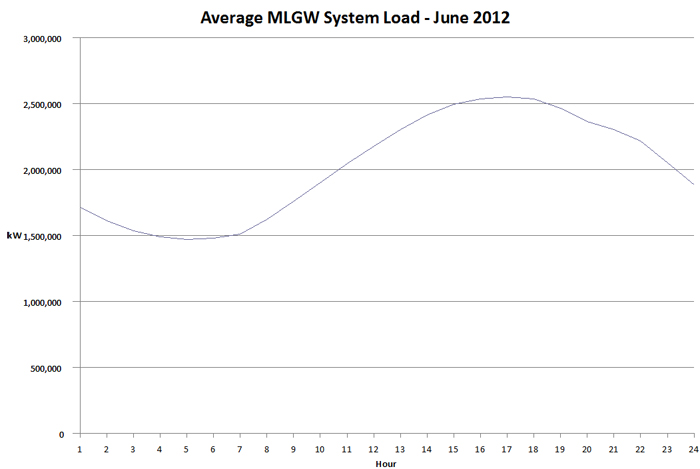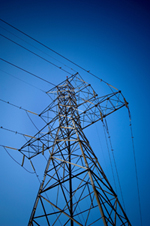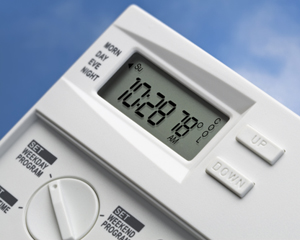MLGW WANTS YOU TO BUY LESS ELECTRICITY
Understanding and Managing Electric System Peaks to Control Utility Rates

Each month, MLGW records an electric system peak based on simultaneous electricity use among its 400,000-plus customers. This system peak can add hundreds of thousands - sometimes millions - of dollars in demand charges to MLGW’s wholesale electricity costs, which are then passed to individual customers through the electric rates, even if the peak lasts just a few minutes.
The reason is simple: the Tennessee Valley Authority (TVA), MLGW’s electric supplier, must supply enough electricity to meet the system peak, no matter how large it is or how long it lasts. TVA can meet that peak by operating reserve power plants, buying supplemental electricity at market prices and/or building new power plants. Each of these options has a significant cost, so TVA bills utilities for peak demand to encourage utilities-and their customers-to help control that peak. By controlling the peak, everyone helps control power costs.
MLGW’s commercial and industrial customers have paid demand charges for years, providing a financial incentive to manage their facilities as efficiently as possible to reduce operating costs. Many of these customers already participate in activities to lower their impact on MLGW’s system peak and others are joining through new voluntary methods.
Customers can play an important role in controlling those late afternoon and early evening system peaks, which are triggered by the combination of commercial buildings not yet in “overnight mode” and household electricity use for non-essential activities (such as electronics left operating and cooling systems running at low temperatures when no one is home).
All customers can help lower utility costs by voluntarily reducing non-essential electricity use during these peak hours. This initiative is based on making the most responsible choices regarding electricity use.
MLGW has developed a “peak shaving” strategy that includes:

- Identifying opportunities to reduce electric use at MLGW facilities during these peak periods, either through conservation (turning off lights in lobbies, meeting rooms and in workspaces near windows), energy efficiency improvements (replacing old, inefficient lighting and cooling equipment with more efficient units) or load control (raising thermostat settings temporarily). These ongoing activities enable MLGW to control its facility operating costs, just like any other business.
- Raising awareness among households, businesses and organizations to encourage simple, no-cost actions to reduce system peak.
If “peak shaving” and “load control” sound confusing, here are some common opportunities:
In the hom e:
e:
- Use a programmable thermostat to control the hours your cooling system operates. If the house is empty, set the thermostat higher during cooling season. If someone is home during the day, consider "pre-cooling," which means lowering the thermostat to cool the house in the hours before the forecasted peak, then raising the thermostat to minimize operation during the peak period. Resume normal operation after the peak period ends. (Remember that the "normal" recommended setting for cooling is 78 degrees when the home is occupied, so pre-cooling would require a lower setting, which then enables the home to gradually warm throughout the day.)
- Use ceiling fans and portable fans to provide great, low-cost supplemental cooling which enables the thermostat to be set at 78 degrees, while still making the room feel 5 degrees cooler due to the breeze. Use fans only when the room is occupied; otherwise, they’re just wasting electricity!
- Delay use of energy-intensive appliances, such as the dishwasher, clothes dryer and swimming pool pumps, during forecasted peak hours. (MLGW's Summer peak hours are 1:00pm to 7:00pm.)
- Use less energy-intensive kitchen appliances for food preparation, such as the microwave and toaster instead of your stove and oven.
- Delay use of energy-intensive personal care devices, such as blow dryers and clothes steamers, during forecasted peak hours.
- Minimize use of electronics and turn off the ancillary devices not in active use, including game consoles, printers and speakers.
In the workplace:
- Reduce lighting in hallways, meeting rooms, restrooms, parking garages and office spaces. Use natural lighting or lower-wattage task lighting to compensate until close of business, then minimize further as employees and customers leave the property.
- Consider installing occupancy sensors in areas only occupied for part of the day, including meeting rooms, restrooms and storage spaces. Sensors use motion detection to turn on when someone enters the room, and then turn off after a period of inactivity. Read about
 MLGW’s experience with occupancy sensors and daylight harvesting at its Netters Business Center.
MLGW’s experience with occupancy sensors and daylight harvesting at its Netters Business Center.
- Post signs to remind employees to take the stairs, instead of the elevator, if they are able.
- Increase the thermostat setting for cooling systems and close window coverings to minimize heat gain, especially on the west in the afternoon.
- Use personal fans to provide low-cost supplemental cooling in key areas to offset some of the thermostat change. Remember to turn off fans when leaving the area.
- Increase the thermostat setting further after employees and customers leave the property.
- Instruct employees to turn off office equipment (and any supplemental task lighting, plus personal fans, radios and other electronics) before leaving for the day.
When is MLGW’s system peak?
Electricity use is highest in Shelby County on weekday afternoons and early evenings. The wide-range is 1:00pm to 7:00 p.m., although the highest part of the curve is usually between 2:00 p.m. and 7:00 p.m. In addition to these being the warmest hours of the day, these are also the hours when homes, stores, offices and all other buildings are collectively using the most electricity simultaneously.
Is this a local problem?
Yes and no. The size of the local system peak certainly drives up local power costs, but system peaks are a universal issue, no matter where you live or work. In states with very tight power supplies (ie, nearly equal available power and demand for power), controlling system peaks is a common way to avoid widespread blackouts. Here are some additional resources:
- California’s Flex Your Power program
- Demand Response 101: The Basics of Utility Load Management Programs

Are you kidding? MLGW really wants me to buy less electricity?
Yes, it’s true! MLGW wants customers to use less electricity overall, but especially during peak hours.
- For some customers, that could mean delaying electricity use until after the system peak-thereby using the same amount of electricity for the exact same tasks, but at different, lower cost hours. That’s known as “load shifting” in the world of energy geeks.
- For other customers, that may mean reducing electricity waste and using fewer units of electricity (kilowatt-hours, or kWh) per month. That’s known as “conservation.” If you achieve it by replacing equipment, that’s called “energy efficiency.” Either way, it means you save money on electricity!
While a business can deliver a greater reduction than a home, it’s important to realize that each little bit counts. Remember that households in Tennessee historically lead the nation for average annual electricity use. In 2013 , the average Tennessee home used 36% (TN) more electricity than the U.S. average. In Shelby County, it was 32% (Shelby Co.) more than the U.S. average. That’s a lot of electricity use-and many, many opportunities for saving money!
, the average Tennessee home used 36% (TN) more electricity than the U.S. average. In Shelby County, it was 32% (Shelby Co.) more than the U.S. average. That’s a lot of electricity use-and many, many opportunities for saving money!
If I use less electricity, doesn’t that mean MLGW will make less money and then will raise my rates?
Good question. Did you know that more than $0.80 of every dollar you spend on electricity goes to TVA to pay for the actual power? MLGW keeps less than 20 cents on the dollar to construct and maintain the electric grid, provide customer service and assist customers. Here’s where the community benefit comes in-if we all help use less power at peak times, then TVA doesn’t need to generate or buy as much power, which holds down TVA’s and MLGW’s electric rates. It’s a win-win-win situation. Please join us!


